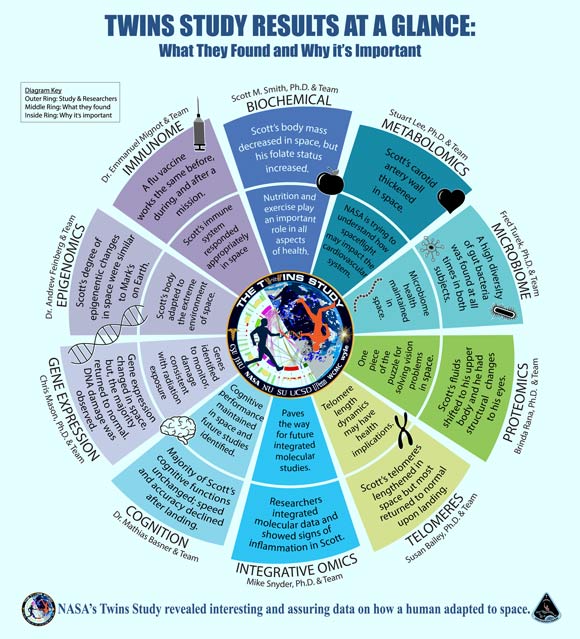Part 5 of 5 Parts (Please read Parts 1, 2,3 and 4 first)
What is next?
NASA’s Human Research Program took advantage of a unique opportunity to carry out the first genomic evaluation of the potential risks that the human body faces during extended periods of spaceflight. The results of the NASA’s Twins Study are not conclusive. The sample size consisted of one set of twins and not every variable was strictly controlled for. The study does provide researcher with a wealth of data to guide future studies on the risks of human spaceflight. NASA stated in a press release that “observations guide development of future hypotheses,” The NASA’s Twins Study has taken the first step in observing how our genomic blueprint is affected by long-term exposure to microgravity and an increased radiation environment. With the information collected as part of this set of studies, NASA has the preliminary data it needs to inform countless more projects for many years to come. The whole Twins Study will be summarized in a paper and each of the projects within the study will publish its own paper.
It is not too soon to begin to consider what countermeasures might be employed to mitigate the effects of space travel on the human body. The problem of microgravity can be countered by setting up a rotation system to mimic the Earth’s gravity. A ring-shaped craft could be used or a pair of chambers at either end of a tether. A ring or tether would have to be about two hundred meters in diameter or length respectively to counter Coriolis forces that would disturb balance. Greater insulating layers of dirt or water or a powerful magnetic field could be used to block space radiation on space stations. Special body suits could be developed to apply pressure to parts of the body to assist in the regulation of the movement of fluids. Electrical fields could be generated by such suits to counter the loss of bone content. We are entering an age of genetic manipulation with the CrisperCas9 technology. It may be necessary to develop new special processes in human bodies to prevent the damage and mutation of DNA and RNA in astronauts. Epigenetics may be modified to control expression of particular genes. Synthetic biology may be used to create new cellular machinery that could protect constituents and processes inside cells.
While many new tools and technologies may be needed to protect human health on long space missions, such developments will not necessarily be restricted to space missions. Technologies developed for space missions have proven to be useful for Earth-bound applications. Without a doubt, some of the health-related technologies developed for use in space will find worthwhile use on Earth. The NASA Twins Study was the beginning of an important field of study on how space travel will impact human health. The research started by the Twins Study will provide the foundation for a much greater understanding of human biology and its manipulation to deal with harsh environments in space or on other astronomical bodies.
